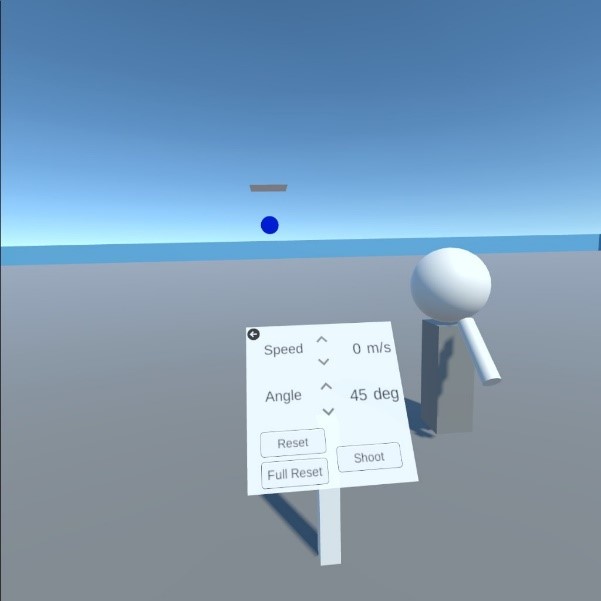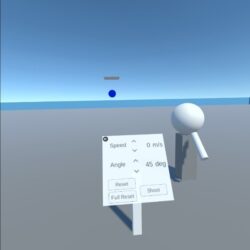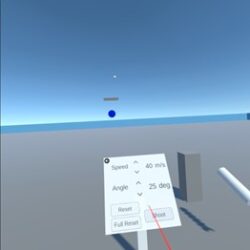VR as a vehicle for experiential learning: A physics case study

Hello readers! My name is Benjamin Hanson and I’m a researcher at the University of Leeds. I’m supported by the Leeds Institute of Teaching Excellence to investigate the specific ways in which virtual reality (VR) can be used to aid teaching of abstract topics in physics. There are theoretical areas of physics which, while experimentally verified, are completely beyond direct human experience. This makes the learning of these topics a distinctly difficult experience, as there are no metaphors to draw upon to aid the discussions. VR provides a method of supplementing the metaphor by providing an immersive environment which accurately displays the theory in action to the best of our current understanding.
The hypothesis of my LITE project is that exposure to aspects of physics that are beyond the human experience in normal reality will develop the experiential, conceptual understanding needed to take the subject forwards. Ideally, it will also make the maths easier to deal with. Human intuition and lateral thinking are difficult to measure, but initial uses of VR in research show that whatever it is, it aids the learning process when engaged though VR [1,2].
Case Study (Pilot) - Trajectories
I developed a VR scenario in which participants could control the angle and speed of a cannon, which fired a ball at a target. The target was 100m away in virtual space (see Figure 1).

Figure 1: The layout of the VR Scenario: “Trajectories”. The ball is shot at the blue target in the distance. The control panel allows the angle and speed of the ball to be altered. The VR scenario is programmed to replicate the idealised principles of Newtonian mechanics.
The pilot session was designed to explore the pedagogical scope of the tool, and the experiment was set up as follows. I invited a number of colleagues, friends and students from around the university to take part in a 1 hour VR session. The spread of disciplines went beyond physics and the fundamental sciences, with psychologists, sociologists and lawyers all in the group. I split the cohort into two, and each group was given a different task. The first group, Group A, were given the task of using the VR scenario to find as many pairs of speeds and angles that they could to make the ball hit the target (Figure 2). Through exploration of the scenario, trial and error, they could fire the ball as many times as they liked, adjusting each time to hone in on a valid speed/angle pair. They were also able to pass the headset between one another each time they found a hit so each person could get a turn.

Figure 2: The ball as it flies towards the target, its behaviour is controlled by Newtonian physics programmed into the scenario. The displayed pair of speed and angle will hit the target.
Group B (which contained only physicists) had the task of calculating the general solution for the speed required to hit the target at some angle. This was a purely mathematical exercise taking place outside of VR…but they did get to have a go at the scenario afterwards!
Each group succeeded at their task but learned different things; Group A explored the scenario experimentally, gaining empirical understanding, whereas Group B explored the scenario theoretically, gaining rational understanding[3]. Of most interest were two qualitative insights. Firstly, Group A were very quickly able to provide a rough estimate of what range of speeds and angles could hit the target, whereas Group B couldn’t do this even once they had the fully solved the equation in front of them. Group B could say “for X angle, you need Y speed” which is highly specific, whereas Group A had a broader, more practical understanding of the parameter space. Loosely speaking, we might say that Group A understood very little but knew a lot, whereas Group B (in principle) understood everything but knew very little.
More interestingly, the members of Group A (who, we remember, were not all physicists or mathematicians) independently discovered a few minor principles of differential calculus as a part of this scenario. After finding the first pair of values via trial and error (as shown in Figure 2), Group A decided that it would be a good idea to slightly vary either the speed or angle to see if that was another pair. If it wasn’t, they varied the other parameter to compensate. What they are doing here (implicitly) is assuming a linear relationship around the current parameters, moving along that linear relationship until it no longer fits, and then adjusting the linear relationship by varying the other parameter. This is Euler (numerical) integration in action, and it was discovered naturally as a way of exploring an empirical parameter space. A very wonderful observation.
The findings from the pilot study are a strong indication that exposure to physical systems does indeed increase mathematical understanding in an almost natural way, even in those who are most likely to say “I can’t do maths”. . As it turns out, they can, and experiential learning was the way to elicit that knowledge and understanding in them. This has informed the construction of these VR scenarios going forwards, as immersion and human interaction have been shown as important aspects of the learning process. It appears that VR is taking constructivist learning to the next level, and allowing students to be truly subjective, active participants in their own learning experience!
You can read more of Ben's work on his personal blog https://abstractacademic.co.uk/academia
[1] M.B. O’Connor, S.J. Bennie, H.M. Deeks, A. Jamieson-Binnie, A.J. Jones, R.J. Shannon, R. Walters, T.J. Mitchell, A.J. Mulholland, D.R. Glowacki, Interactive molecular dynamics in virtual reality from quantum chemistry to drug binding: An open-source multi-person framework, J. Chem. Phys. 150 (2019) 220901. https://doi.org/10.1063/1.5092590.
[2] H.M. Deeks, K. Zinovjev, J. Barnoud, A.J. Mulholland, W. Marc, V. Der Kamp, D. Glowacki, Virtual reality sampled pathways guide free energy calculation of protein-ligand binding, ChemRxiv. (2022). https://doi.org/10.26434/chemrxiv-2022-w89tc.
[3] Dummies. (2021, December 5). Philosophical Battles: Empiricism versus Rationalism. dummies.com. Retrieved April 18, 2023, from https://www.dummies.com/article/body-mind-spirit/philosophy/general-philosophy/philosophical-battles-empiricism-versus-rationalism-200935/
